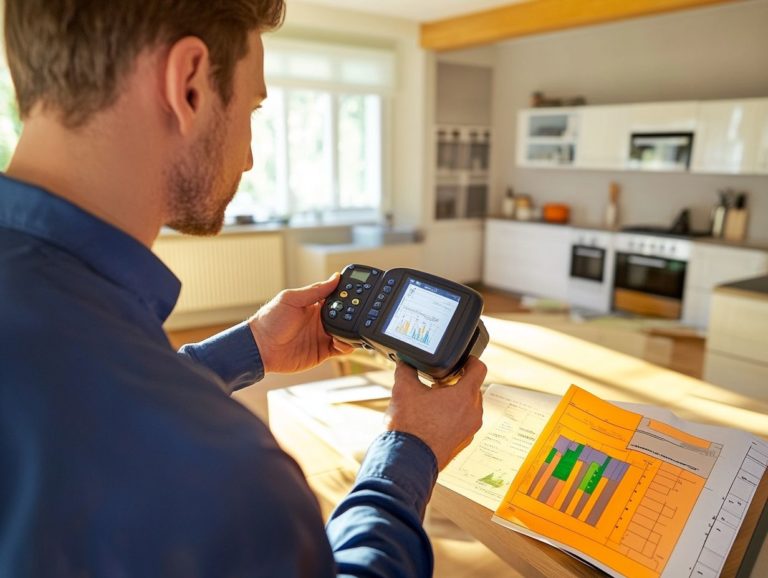How Energy Audits Contribute to Climate Goals
Energy audits serve as invaluable tools for you, whether you’re a business owner or a homeowner. They aim to enhance energy efficiency and minimize your environmental impact.
This article delves into what energy audits are, the different types available, and the pivotal role they play in realizing climate goals.
You ll discover the audit process, which emphasizes key benefits like financial savings, environmental advantages, and actionable recommendations.
By grasping how energy audits can pinpoint inefficiencies and promote sustainable practices, you ll be equipped to make a meaningful impact on your energy consumption and contribute to a greener future.
Contents
- Key Takeaways:
- Understanding Energy Audits
- Importance of Energy Audits in Achieving Climate Goals
- Reducing Energy Consumption and Carbon Footprint
- The Process of Conducting an Energy Audit
- Benefits of Energy Audits
- Implementing Energy Audit Recommendations
- Future of Energy Audits in Climate Action
- Frequently Asked Questions
- What is an energy audit and how does it contribute to climate goals?
- How does an energy audit help reduce greenhouse gas emissions?
- Who can benefit from an energy audit?
- What types of energy-saving measures are typically recommended in an energy audit?
- How often should an energy audit be conducted?
- Are there any financial incentives for conducting an energy audit?
Key Takeaways:

Energy audits play a vital role in helping achieve climate goals by reducing energy consumption and identifying inefficiencies. The process of conducting an energy audit involves a step-by-step guide and provides various benefits such as financial savings and environmental benefits. To learn more about the link between energy audits and sustainability, act now to unlock the full potential of these assessments by implementing the recommended strategies and making them a key component of future climate action plans.
Understanding Energy Audits
Understanding energy audits is essential in today s journey toward sustainable development and environmental sustainability.
These audits are pivotal in uncovering energy-saving opportunities that can dramatically reduce greenhouse gas emissions and carbon footprints, especially when you learn how to make energy audits work for you.
By assessing energy consumption patterns and performance across different energy systems, you can adopt effective energy management software and strategies. Ultimately, this enhances energy efficiency and addresses the impacts of climate change.
What is an Energy Audit?
An energy audit is a meticulous examination of energy usage and efficiency within your building or facility. It is designed to reveal potential energy savings and optimize overall performance.
This thorough evaluation typically entails analyzing your energy consumption patterns, conducting detailed walkthrough inspections, and employing specialized tools to measure energy flow.
The goal is to uncover inefficiencies such as outdated lighting, insufficient insulation, and malfunctioning HVAC systems, which contribute to unnecessary energy consumption.
By closely examining these factors, energy audits serve as a vital tool for identifying areas ripe for improvement and ultimately enhancing your energy efficiency.
By integrating the insights gained from these audits, you can enable yourself whether as a facility manager or a homeowner to implement targeted strategies that significantly reduce your overall energy costs while promoting sustainable practices.
Types of Energy Audits
There are several types of energy audits tailored to meet diverse energy management needs and systems. These include walk-through audits, detailed audits, and investment-grade audits.
A walk-through audit is your go-to for a swift evaluation of energy use. It’s ideal for businesses looking for immediate insights into energy-saving opportunities without committing a lot of time or resources.
If you want to dive deeper, a detailed audit employs advanced methodologies to quantify energy efficiency strategies. It assesses how various systems operate and identifies potential energy retrofits that could make a substantial difference.
For those seeking the most thorough analysis, investment-grade audits stand out as they involve extensive financial scrutiny and detailed reporting, clearly showcasing potential returns on investment.
Technological advancements like smart meters and IoT devices change the game in these audits. They provide real-time data that enables you to track consumption patterns and make informed decisions, ultimately leading to greater energy efficiency.
Importance of Energy Audits in Achieving Climate Goals
Energy audits serve as crucial instruments in your battle against climate change. These audits offer invaluable insights into your energy consumption patterns, enabling you to craft effective strategies that not only reduce your carbon footprint but also help lower your energy costs. Discover more about the benefits of going green with energy audits.
Now is the perfect time to consider an energy audit for your home or business. By taking this proactive step, you can contribute to a sustainable future and enjoy the benefits of reduced energy bills.
Reducing Energy Consumption and Carbon Footprint
One of the primary benefits of energy audits is their ability to identify specific areas where you can reduce energy consumption. This ultimately lowers your facility’s carbon footprint.
These assessments thoroughly evaluate your existing energy systems and uncover inefficiencies that might have gone unnoticed. By analyzing usage patterns and conducting inspections, energy audits reveal tailored energy-saving measures designed specifically for your facility.
Implementing these measures not only boosts energy efficiency but also leads to significant cost savings over time. For instance, upgrades to lighting, heating, ventilation, and air conditioning (HVAC) systems, and insulation can dramatically enhance performance while reducing waste.
Our goal is to create a sustainable energy future, ensuring your facility operates at its best while positively contributing to the environment.
Identifying and Addressing Energy Inefficiencies
Energy audits are essential for identifying and rectifying energy inefficiencies that can lead to high costs and waste across various systems.
By systematically examining your energy consumption, these audits use advanced techniques like data collection, energy management software analysis, and thermal imaging to highlight areas needing improvement.
This valuable insight allows you to implement customized energy efficiency strategies, ensuring every aspect of your energy consumption is optimized for cost-effectiveness.
By embracing energy optimization practices, you not only reduce operational expenses but also contribute to a more sustainable environment.
This proactive approach to energy management paves the way for significant savings while enhancing overall productivity.
The Process of Conducting an Energy Audit

Conducting an energy audit involves a series of essential steps guiding you through the process.
- Begin with thorough data collection.
- Follow this with a meticulous analysis of your energy consumption patterns.
- Finally, focus on implementing targeted energy efficiency measures designed to elevate your overall energy performance.
Taking these steps will not only optimize your energy use but also contribute to a more sustainable future.
Step-by-Step Guide
A step-by-step guide to conducting an energy audit typically begins with initial assessments, data gathering, financial analysis, and crafting energy-saving recommendations.
This structured approach allows you to pinpoint specific areas where energy is wasted, unlocking significant savings through improved efficiency. The first stage often involves a thorough visual inspection of your facility, helping you identify potential issues like air leaks or outdated equipment.
Next, data gathering comes into play. You ll collect utility bills and operational schedules to feed essential information into a financial analysis, evaluating costs and potential returns on your energy investments.
Utilizing tools like thermal imaging cameras during assessments can uncover heat loss and highlight inefficiencies. Meanwhile, energy management software streamlines data tracking and helps you formulate actionable recommendations that enhance energy performance and align with your sustainability goals.
Benefits of Energy Audits
The advantages of energy audits extend far beyond compliance. They offer substantial financial savings, positively impact the environment, and enhance energy management for organizations committed to sustainability.
Embracing this practice aligns you with regulatory standards and positions your organization as a leader in efficient resource use.
Start your energy audit journey today to save money and protect the planet!
Financial Savings
One of the most compelling benefits of conducting energy audits is the potential for significant financial savings through reduced energy costs and the implementation of energy-saving measures.
Energy audits give you valuable insights into how you use energy. This helps you find inefficiencies and discover personalized solutions to save energy.
For example, imagine a manufacturing plant that undertook an energy audit and discovered it could save up to 30% on its annual energy bill simply by upgrading to energy-efficient lighting and optimizing its heating and cooling systems.
Similarly, consider a commercial office building that adopted energy efficiency strategies based on audit recommendations and witnessed a return on investment within just two years.
These real-world examples underscore how systematic reviews of energy use can lead not only to immediate cost reductions but also to lasting sustainability benefits.
Environmental Benefits
Energy audits provide remarkable environmental advantages, allowing you to significantly reduce your greenhouse gas emissions and champion sustainable practices.
By pinpointing inefficiencies in your energy usage, these assessments enable you to adopt energy conservation measures that can lead to a substantial decrease in your carbon footprint.
When you commit to optimizing your energy consumption, you not only boost operational efficiency but also play a vital role in nurturing a healthier planet.
The insights you gain from these audits can inspire a transition towards renewable energy sources and advanced technologies, cultivating a culture of environmental responsibility within your organization.
Ultimately, these initiatives foster sustainability across various sectors, ensuring that resources are utilized judiciously and preserved for generations to come.
Implementing Energy Audit Recommendations
Implementing the recommendations from energy audits is essential for unlocking the energy-saving opportunities identified and elevating the overall energy efficiency within your organization.
Strategies for Implementation
Effective strategies for implementing energy audit recommendations involve setting clear goals, using software that helps track and improve energy use, and actively engaging stakeholders throughout the entire process.
By adopting these practices, you can cultivate a proactive framework that encourages collaboration and enthusiasm around your energy efficiency initiatives.
Incorporating technology, such as smart building design, plays a crucial role in achieving these objectives. These innovative systems automate energy usage, optimize performance, and enable real-time monitoring, ultimately leading to more informed decision-making.
Utilizing energy monitoring tools allows you to track consumption patterns, making it easier to identify adjustments that can significantly enhance your energy management.
Together, these approaches not only streamline the adoption of energy-saving measures but also foster a culture of sustainability within your organization.
Future of Energy Audits in Climate Action

Get ready! The future of energy audits is about to revolutionize climate action for you.
As they evolve, they will incorporate innovative technologies, renewable energy sources, and advanced energy efficiency strategies.
This evolution will enable your organization to transition toward net-zero emissions with confidence and purpose.
Potential Impact and Role in Achieving Climate Goals
The potential impact of energy audits on your climate goals is truly significant. They help you identify pathways for improving energy efficiency and integrating renewable energy into your systems.
By conducting a thorough assessment of your current energy usage, you can pinpoint inefficiencies and implement strategies that reduce costs while also minimizing your environmental impact.
For example, a manufacturing firm might achieve substantial energy savings simply by replacing outdated machinery with more efficient models or recalibrating its heating and cooling systems.
An energy audit can also guide you in transitioning to renewable energy sources, such as solar or wind, aligning your operations with modern sustainability practices.
The insights you gain from these audits ultimately enable you to make informed decisions, enhancing your contribution to global climate targets.
Start your energy audit today and unlock potential savings!
In summary, energy audits not only provide financial benefits but also drive environmental sustainability and operational efficiency. Take action now to make a positive impact!
Frequently Asked Questions
What is an energy audit and how does it contribute to climate goals?
An energy audit is a simple evaluation of how energy is used in a building. It identifies energy waste and inefficiencies, offering recommendations for improvement. By following these suggestions, buildings can reduce their energy use and help achieve climate goals by lowering their carbon footprint.
How does an energy audit help reduce greenhouse gas emissions?
An energy audit helps cut greenhouse gas emissions by pinpointing sources of energy waste. When buildings implement energy-saving measures from the audit, they consume less energy, which leads to reduced greenhouse gas emissions.
Who can benefit from an energy audit?
Anyone who owns or manages a building can benefit from an energy audit. This includes homeowners, business owners, and facility managers. It can also enhance comfort for tenants and building occupants, creating a more efficient living or working environment.
What types of energy-saving measures are typically recommended in an energy audit?
Common recommendations from energy audits include upgrading to lights that save energy, improving insulation, using energy-saving appliances, and incorporating renewable energy sources. Suggestions vary based on the building’s specific needs.
How often should an energy audit be conducted?
Conduct energy audits every 3-5 years to ensure maximum efficiency. The frequency may depend on the building’s age, condition, changes in energy costs, and the implementation of previous audit recommendations.
Are there any financial incentives for conducting an energy audit?
Yes! There are often financial incentives like rebates, grants, tax credits, and low-interest loans for conducting energy audits and implementing energy-saving measures. Research available incentives before starting an energy audit to unlock incredible savings!







